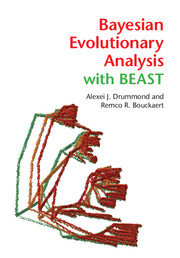Preface
Published online by Cambridge University Press: 05 October 2015
Summary
This book consists of three parts: theory, practice and programming. The theory part covers theoretical background, which you need to get some insight in the various components of a phylogenetic analysis. This includes trees, substitution models, clock models and, of course, the machinery used in Bayesian analysis such as Markov chain Monte Carlo (MCMC) and Bayes factors.
In the practice part we start with a hands-on phylogenetic analysis and explain how to set up, run and interpret such an analysis.We examine various choices of prior, where each is appropriate, and how to use software such as BEAUti, FigTree and DensiTree to assist in a BEAST analysis. Special attention is paid to advanced analysis such as sampling from the prior, demographic reconstruction, phylogeography and inferring species trees from multilocus data. Interpreting the results of an analysis requires some care, as explained in the post-processing chapter, which has a section on troubleshooting with tips on detecting and preventing failures in MCMC analysis. A separate chapter is dedicated to visualising phylogenies.
BEAST 2.2 uses XML as a file format to specify various kinds of analysis. In the third part, the XML format and its design philosophy are described. BEAST 2.2 was developed as a platform for creating new Bayesian phylogenetic analysis methods, by a modular mechanism for extending the software. In the programming part we describe the software architecture and guide you through developing BEAST 2.2 extensions.
We recommend that everyone reads Part I for background information, especially introductory Chapter 1. Part II and Part III can be read independently. Users of BEAST should find much practical information in Part II, and may want to read about the XML format in Part III. Developers of new methods should read Part III, but will also find useful information about various methods in Part II.
The BEAST software can be downloaded from http://beast2.org and for developers, source code is available from https://github.com/CompEvol/beast2/. There is a lot of practical information available at the BEAST 2 wiki (http://beast2.org), including links to useful software such as Tracer and FigTree, a list of the latest packages and links to tutorials. The wiki is updated frequently. A BEAST users' group is accessible at http://groups.google.com/group/beast-users.
Information
- Type
- Chapter
- Information
- Publisher: Cambridge University PressPrint publication year: 2015
